Michelin Defenders are very famous, but how would they perform against one of the best all season tires out there? Well, we tested them vigorously and have some interesting results for you.
The Crossclimate 2 is basically a combination of a touring and a dedicated winter tire. That’s why it has the arrow like directional pattern common with all winter tires.
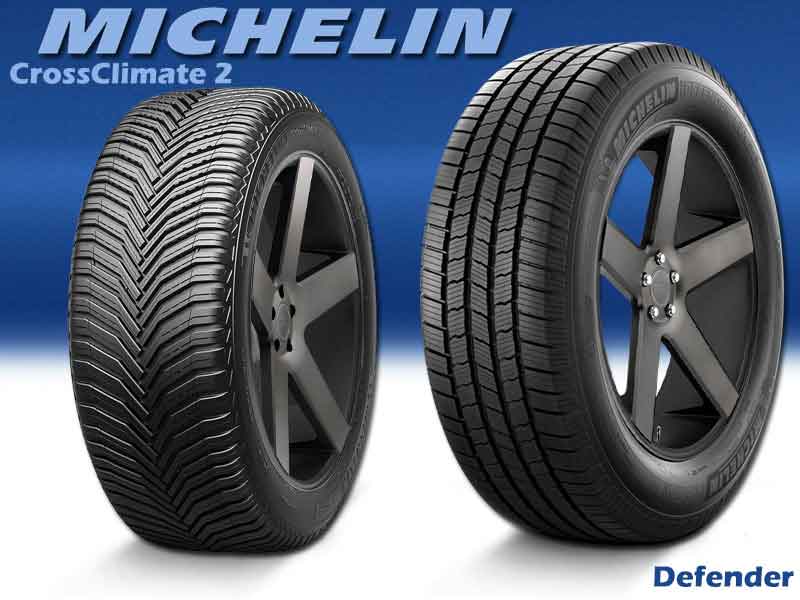
On the other side, the Michelin Defender LTX (see difference between AT2 & LTX MS), characterizes alternating continuous ribs and grooves like a classic all season tire.
Also check out: Michelin Defender 2 vs Crossclimate 2.
Table of Contents
How They Performed in Winter?
Let’s start this off with Michelin Crossclimate 2.
Right off, you’ll notice the directional design of this tire and the long swooping lugs that come all the way from the shoulders, towards the center. (See image below).
Note: We tested both of these tires on with following specs:
| Crossclimate 2 | Defender LTX | |
| Usage | Grand touring | Highway |
| 3PMSF | yes | no |
| Tested size | 235/60R18 107H XL | 235/60R18 107H XL |
| Tread depth | 10/32’’ | 12/32’’ |
| Tread width | 6.8’’ | 7.3’’ |
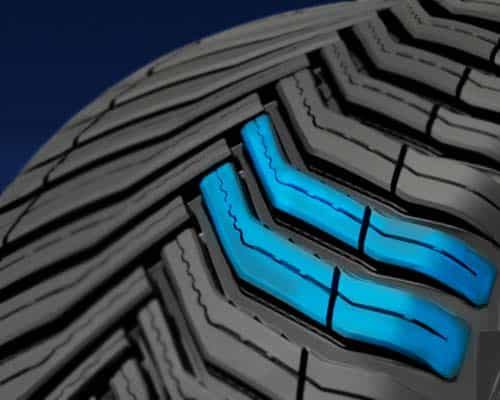
As beautiful as this design looks, its not for show at all.
These lugs act as traction spoons and they scoop up the snow/ice/slush.
You can consider them as “spoons”, pushing snow backwards as the tire rolls, keeping the grip connected with the ground.
This directional design, allows this tire to be branded with 3 peak mountain snow flake rating (missing in Michelin Defender).
Other than this, these lugs also feature biting edges. These notches/incisions crush the snow particles further as they pass through.

Other than all this, its thermal adaptive polymer also stays relatively softer like other winter tires (I’ll get to that in a bit).
On the other hand, in we look at the Michelin Defender, it has 4 longitudinal grooves, formed by the tread blocks seen all over. All these tread blocks have sharp offset edges to them as well (see the left side of these blocks below).
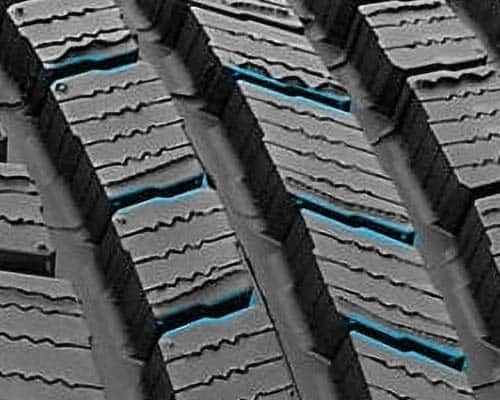
Similarly the lateral gaps between the blocks also form an uneven path. (And they are even wider on the shoulders, see in the image below).
So these gaps a long with numerous zig-zag sipes seen on all blocks trap in the snow. And this helps the tire in traction. Why? Well…
Because snow sticks better on snow put simply (Basically the snow particles have an interlocking design and they lock with other snow particles easily).
But still the tire was left behind a little bit.
| Tests | CrossClimate 2 | Defender LTX MS |
| Snow Braking | 88 feet | 96 feet |
| Snow Handling | 25 mph | 20 mph |
In comparison to Michelin Crossclimate 2, the Defender had shorter braking distances and lesser average lap speeds (on snowy tracks).
How they performed on Dry Roads?
Winter tires with their softer material perform best in temperatures below 44 Degree F. So they can’t be used in summer, as their tread would wear off very quickly.
And to tackle this issue, both of these Michelin all season tires are built with temperature adaptive polymers, that don’t go too soft in summer or too stiff in winter.
But still the Crossclimate 2 showed a better grip with its lower braking distance while both tires performed equally in dry handling.
| Tests | CrossClimate 2 | Defender LTX MS |
| Dry Braking | 123 feet | 137 feet |
| Dry Handling | 56 mph | 56 mph |
If we talk about the Michelin Crossclimate 2, the tire with its V-Ramp Chafing of central ribs allows it to have amazing grip. This tire simply has more contact with the road in comparison, so it performs better here.
That’s because the Michelin Defender looses a lot of it’s contact patch through the grooves, siping and blocks formation.
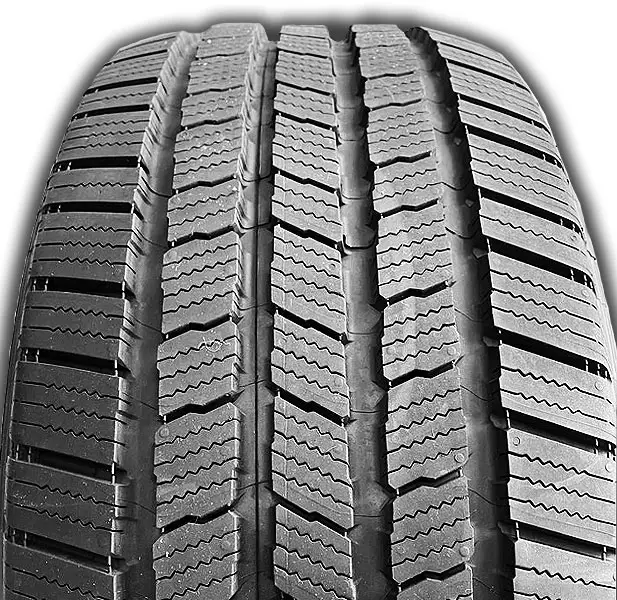
Without these longitudinal grooves and a ton of siping that you see on the Defender, the Crossclimate 2 simply offers more surface area to touch the ground and this results in better grip.
But grip is only one part of summer traction. The other one is handling. And both of these tires performed equally here.
What about wet roads?
Overall here, the Michelin Defender showed better traction on wet roads with better gripping, handling and resistivity to hydroplaning.
| Tests | CrossClimate 2 | Defender LTX MS |
| Wet Braking | 177 feet | 168 feet |
| Wet Handling | 45 mph | 46 mph |
| Float Speeds | 58 mph | 59 mph |
With minimal siping, the Crossclimate 2 increases contact with the road, but has to lose some of its traction on wet (in comparison).
But the they did not compromise on this too much. The tire still has some siping and it’s right in the place where you need them the most.
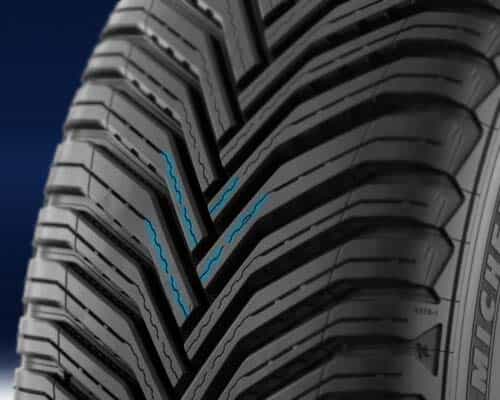
Basically, the tire was made round (curved edges of tire sides). So its central area has the most contact with the road so siping was very important here.
Each block carry sipes that are mostly rectilinear, but they become wave-like in the central portion of the tire. These sipes also split up in the end there.
All these things give this tire great traction values even on wet.
The straight siping on the shoulders (as seen with bold prominent lines) aid the tire in lateral traction.
These sipes are very deep and go all the way to the base, so the blocks are further divided, allowing them to squirm/squeeze according to their action on the road.
Also since the tire’s shape is rounded, the sides of the tire can easily allow water to channel through the grooves as it moves out. This allows this tire to have high float speeds as well.
On the other side, the Michelin Defender also performed great here. Its substantial handling is explained by its bulkier shoulder blocks which come into action during cornering.
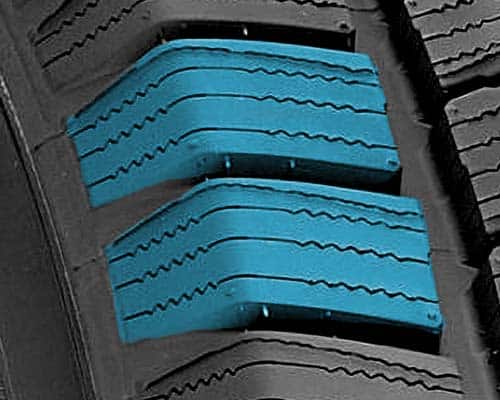
Besides that, the high density of full-depth 3D sipes are seen everywhere on this tire.
FYI: The basic job of these sipes is wiping water away, and reducing the overall stiffness in blocks, and they do that efficiently.
But interestingly, they also multiply the tire’s gripping edges because these sipes are also changing their pattern on all blocks (from zig-zag to straight).
All these things combined provide excellent traction over wet pavements.
Furthermore, the continuous 4 circumferential channels, with more tread depth allows it to have an enhanced hydroplaning resistivity (as the tire has more water evacuation capability).
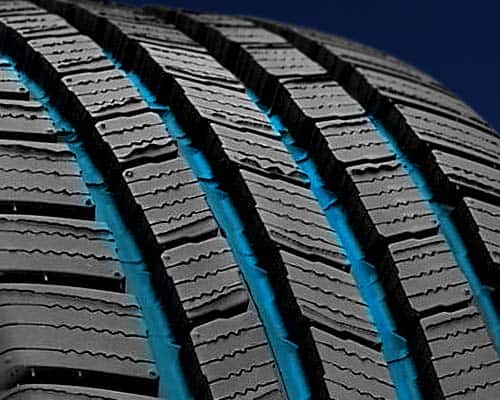
In contrast, the Michelin Crossclimate 2’s circular tread also efficiently directs water out from its lateral grooves, however, shallower channels provide lesser water holding capacity and fewer sipes lead to decreased water wiping efficiency.
Which tire will last longer?
The Crossclimate 2 is molded from thermal adaptive all-season compound which is relatively softer and specifies lesser wear protection in comparison.
Defender is a comparatively more durable all-season tire due to its EverTread composition and open tread pattern.
So its tread polymer wears down quite slowly and it shows a good weather resistance.
This tire specifies polymer structuring over twin steel belts, hence, its internal structure is also robust.
Other Deciding Factors
There were some other tests as well that we performed and although the differences were quite low, its still shows one better.
| CrossClimate 2 | Defender LTX MS | |
| Fuel Consumption | 28 MPG | 26 MPG |
| Noise | 70 dBs | 71.5 dBs |
| Price | Expensive | Cheaper |
| Treadwear warranty | 60k miles | 70k miles |
Higher grip usually means more rolling resistance but its the opposite with the Crossclimate 2.
With less rolling resistance, less hysteresis is produced when this tire moves. So it gives out better mileage in comparison.
These tires were also quieter.
Usually the tires with bigger shoulder voids have more noise. And that’s one of the reason why these tires were made directional.
Noise is basically created when air particles hit the surface of the tread, and with directional design of the Crossclimate 2, the air has a lot of room to move around so it doesn’t hit the walls as hard.
But all these cool features of this tires don’t come cheap.
Out of all the seasonal tires we reviewed, these were the most expensive of them all.
And yes one last thing, as these tires are directional, their rotation becomes a bit complicated as they can only be rotated vertically.